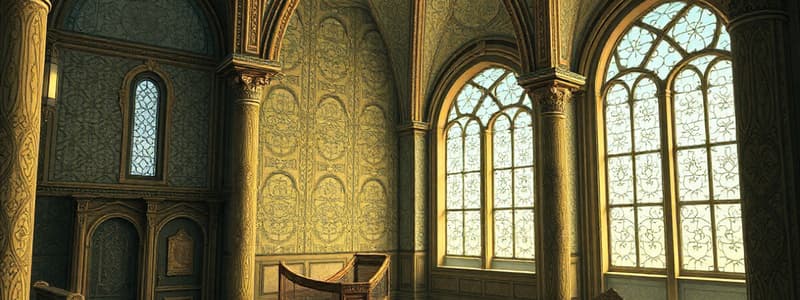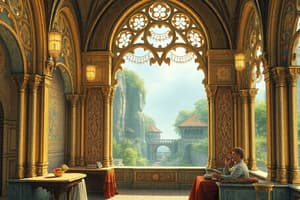Podcast
Questions and Answers
What type of subjects are primarily depicted in Byzantine painting?
What type of subjects are primarily depicted in Byzantine painting?
- Nature and landscapes
- Historical events
- Mythological themes
- Christian subjects (correct)
What significant architectural innovation is associated with Byzantine architecture?
What significant architectural innovation is associated with Byzantine architecture?
- Flying buttresses
- Perfected dome construction (correct)
- Crafted stone vaults
- Pointed arches
Which feature characterizes Romanesque painting?
Which feature characterizes Romanesque painting?
- Strict frontal poses and elongated faces (correct)
- Horizontal composition with multiple perspectives
- Realistic human proportions
- Vivid use of color and shading
What elements are commonly found in Romanesque architecture?
What elements are commonly found in Romanesque architecture?
What materials were typically used for small individual works of art in Romanesque sculpture?
What materials were typically used for small individual works of art in Romanesque sculpture?
The Gothic style of art emerged from which preceding art form?
The Gothic style of art emerged from which preceding art form?
Which mosaic is associated with Empress Theodora in Byzantine art?
Which mosaic is associated with Empress Theodora in Byzantine art?
What is a common architectural feature of Romanesque churches?
What is a common architectural feature of Romanesque churches?
Flashcards are hidden until you start studying
Study Notes
Byzantine Art
- Focused on Christian subjects, with significant development by the 11th century.
- Featured a blend of Greek and Oriental styles, showcased in churches through large and small forms.
- Notable piece: The court mosaic of Empress Theodora from the 6th century AD at San Vitale, Ravenna.
- Empress Theodora depicted as an Asian queen with dark eyes and fierce expression.
- Advancements in dome construction led to unique architectural styles and perfected mosaic decoration in churches.
Romanesque Art
- Period of art in Europe from around 1000 AD; serves as a transitional style between Roman and Gothic.
- Characterized by mosaics placed on church walls, featuring strict frontal poses with elongated figures.
- Art subjects depicted with large, staring eyes, long noses, and flat colored bands with heavy outlines.
Romanesque Sculpture
- Included significant works such as reliquaries, altar frontals, crucifixes, and devotional images.
- Small artworks often made from costly materials for royal and aristocratic patrons.
- Lightweight devotional pieces were carried in processions; notable work is The Last Judgment by Gislebertus adorning the west tympanum of Cathédrale Saint-Lazare d’Autun.
Romanesque Architecture
- Design is characterized by solid masonry walls, rounded arches, and masonry vaults.
- Era known for extensive building activities, leading to the construction of castles, churches, and monasteries across Europe.
- Grand sculptured portals mark the entrance of Romanesque churches, often accompanied by elaborate stone sculptures surrounding the doorways.
Gothic Art
- Emerged in Northern France during the 12th century as a style of medieval art, evolving from Romanesque influences.
Studying That Suits You
Use AI to generate personalized quizzes and flashcards to suit your learning preferences.




